 The current drought in large portions of the United States makes the need for water-wise gardens more important than ever. But that doesn’t mean our gardens can’t look attractive.
The current drought in large portions of the United States makes the need for water-wise gardens more important than ever. But that doesn’t mean our gardens can’t look attractive.
That’s why Seasonal Wisdom turned to Noelle Johnson for some drought-tolerant plant suggestions. This talented horticulturist runs AZ Plant Lady landscape consulting in Chandler, Arizona and she spends her working hours making low-water gardens beautiful.
Check out five of Noelle’s favorite drought-tolerant plants, and get her expert gardening tips for growing them.
All photos are copyright to Noelle Johnson.
In Noelle Johnson’s Own Words:
Many people have the mistaken impression that drought-tolerant plants are boring, but nothing can be further from the truth. Just because a plant thrives on little water, doesn’t mean a water-wise garden is devoid of interest. In fact, the reality is quite the opposite. Countless plants add welcome beauty to the landscape while only needing deep, infrequent watering.
Drought-tolerant plants require well-drained soil, so before planting, amend the soil with 1 part compost to 1 part native soil.
Here are a few of my favorites:
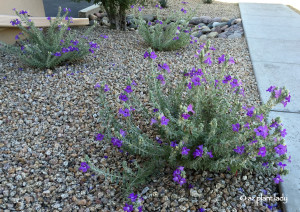 ‘Blue Bells’ (Eremophila hygrophana) – This is a newer shrub, which is prized for its compact growth habit and low-pruning requirements. Vibrant violet flowers appear throughout the entire year above blue/gray foliage.
‘Blue Bells’ (Eremophila hygrophana) – This is a newer shrub, which is prized for its compact growth habit and low-pruning requirements. Vibrant violet flowers appear throughout the entire year above blue/gray foliage.
Size: 3 feet tall and wide; Attracts Hummingbirds
Hardy to zone 8; Full sun to light, filtered shade
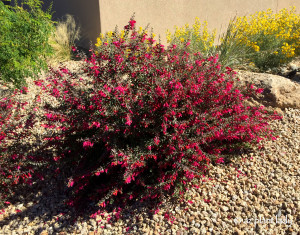
‘Valentine Bush’ (Eremophila maculata ‘Valentine’) – The dark green foliage of this Australian native transforms in winter with the appearance of hot pink to red, tubular blossoms, which add badly needed color to landscapes in winter on into early spring. Maintenance is low, with them only needing pruning once a year in late spring after flowering has finished.
Size: Up to 4 feet tall and 4-5 feet wide, although it can be maintained at a smaller size.
Hardy to zone 8. Full sun.
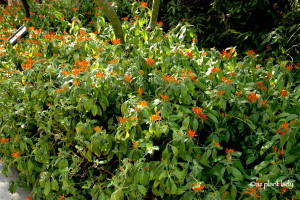 Mexican Honeysuckle (Justicia spicigera) – This small shrub is an ideal choice for areas that receive light, filtered shade where it will produce narrow, orange tubular flowers all year long, much to the delight of hummingbirds. The bright green foliage adds a visually cooling element to the garden.
Mexican Honeysuckle (Justicia spicigera) – This small shrub is an ideal choice for areas that receive light, filtered shade where it will produce narrow, orange tubular flowers all year long, much to the delight of hummingbirds. The bright green foliage adds a visually cooling element to the garden.
Size: 3 to 4 feet tall and wide; Hardy to zone 8
Attracts hummingbirds; Filtered shade
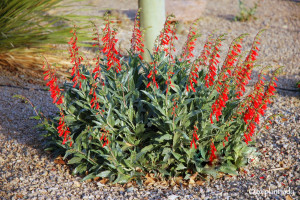
Firecracker Penstemon (Penstemon eatonii) – Many different species of penstemon grow throughout the western U.S. and are appreciated for their beautiful flowering spikes. This particular penstemon has red/orange blossoms that appear in winter and last through spring, attracting butterflies and hummingbirds. When not in bloom, it fades into the background while warm-season flowering plants take center stage.
Size: 1 to 2 feet wide, and 2 feet tall when in flower; Hardy to zone 5; Attracts hummingbirds; Full sun
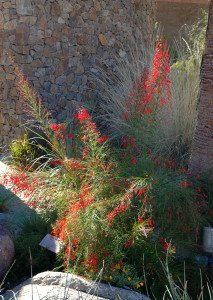
Coral Fountain (Russelia equisetiformis) – The cascading, needle-like foliage of this shrubby perennial is attractive on its own, adding a tropical feel to the garden. However, the appearance of small, orange/red flowers adds stunning beauty wherever it’s planted. Hummingbirds can’t resist the flowers, which last spring through fall and even winter, in frost-free areas.
Size: 3 feet tall and 4 feet wide; Hardy to zone 8
Attracts hummingbirds; Full sun to light shade
Noelle’s Tip: Once established, water each plant deeply approximately 3-4 times a month in summer, 2-3 times a month in spring/fall, and every three weeks in winter.
More Garden Resources:
Growing container gardens? Don’t miss Noelle’s advice in this Associated Press article published in the Washington Post.
Want more drought tolerant tips? Check out this advice for a water-wise garden from expert Nell Foster.
Connect with Noelle Johnson of AZ Plant Lady











Comments on this entry are closed.